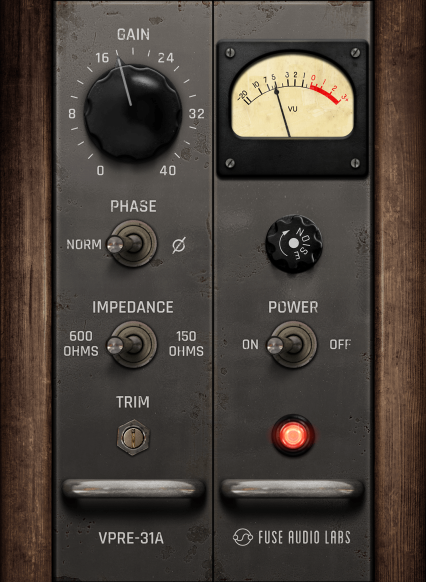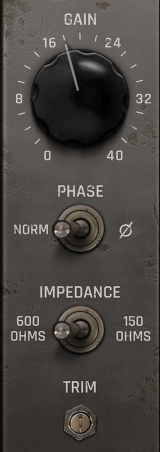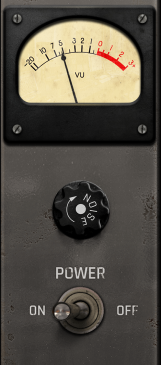If you enjoy this review and decide to grab the deal, please consider clicking through one of my links before you buy. I earn a small commission at no cost to you, which helps support this site and keep the reviews coming. Thanks!
Fuse Audio Labs has garnered a reputation for taking cool and rare vintage gear and emulating its tonal footprint while adding fun, usable features. Their newest release, VPRE-31A, is a recreation of RCA’s ultra-rare BA-31A Germanium Preamp. The original has a fixed 40dB gain and nothing but a power switch, while Fuse’s version is a reimagining with a gain dial, impedance switch, and more. How will Fuse’s emulation stack up? Let’s check it out.
Looks

VPRE-31A opens to what looks like two RCA BA-31a’s side by side, with many of the subtle details found in the original, down to the knurling on the fuse holder and the steel pullout bars. The aged appearance harkens back to its early 60s flat-grey paintjob with white silkscreened lettering, and the big metal toggle switches are period-accurate. Unlike the original unit, VPRE-31A has a gain dial, phase switch, impedance switch, VU meter, and jewel light. It’s exactly what I’ve come to expect from Fuse – a clean, attractive, and accessible visual update of the original hardware.

Features
Though there are only a few controls in VPRE-31A, compared to the original RCA unit it’s a veritable playground. Let’s check out all the bells and whistles:
Gain, Phase, Impedance, and Trim

The RCA BA-31A had nothing but a power switch and a fuse holder, so all of these controls are products of Fuse Audio Labs’ vision. The Gain control allows you to dial in just the right touch of vintage warmth and saturation and feels more like a mix knob than a gain, while the phase gives you control over the waveform once the performance is baked in. The original RCA unit did technically have the ability to switch between 150 and 600 ohms impedance, but not via a toggle switch. Instead, users would have to change how the unit was wired via the strap terminals on the rear, making it a tedious operation. Finally, the Trim control, which looks like a screw, gives you up to 18dB of boost or cut.
Meter, Noise, and Link

Also not present on the original unit, the VU meter is toggleable between input, output, and post drive and is zeroed to -14dBFS. The Noise control has a range of -140 through -60dB and brings in a subtle hiss, or can be removed completely by turning it all the way to the left. The Link control (not pictured) allows you to control all of your instances of VPRE-31A simultaneously, which is particularly useful for stereo pairs or busses.

Usability
VPRE-31As overall ease of use is one of my favorite aspects. First of all, I found the Gain control to be pleasantly subtle and usable throughout the dial. I didn’t have to constantly monkey around with the output volume to get a nice breakup from the Gain without clipping the meters like I do with some other preamp emulations. Then, then using VPRE-31A on multiple channels, the Link control was invaluable for auditioning different settings. In my acoustic guitar sample there are two mics panned left and right, so being able to turn the Gain dial on both channels simultaneously is a brilliant feature for setting up the right amount warmth and saturation. The Impedance and Noise features are a nice touch for adding some vintage vibe and providing two distict tonal characters. Last but not least, VPRE-31A merely sips CPU power, using only 0.8% of my CPU during my test. That’s lower than nearly any other plugin I use and quite similar to Fuse’s VPRE-2C I reviewed last year.

Hear it in Action
I pulled two samples of VPRE-31A in action. Both of these used the Vintage Vibe preset, which sets the impedance to 600 ohms and the noise to -85dB, then I dialed the gain back just a touch. First up is a vocal sample from an upcoming review of the new Aston Element. I thought I’d see how VPRE-31A treated the raw performance directly into my interface, and I was very pleased:
Here’s the dry sample for comparison. Note how in the previous sample, VPRE-31A took out just a bit of the top end and added a pleasing saturation:
Next up is an acoustic guitar track that I also used in my review of VPRE-2C from Fuse. I like what VPRE-31A does even more, especially with the added Link feature:
Here’s the dry track, which contrasts again with the warmth and saturation VPRE-31A adds:
Fuse Audio Labs VPRE-31A Review – The Bottom Line
As one of Fuse Audio Labs’ most affordable plugins, you can’t deny the value of VPRE-31A. Though beginners may find this plugin a bit subtle, more experienced ears will really appreciate the slight top-end rolloff, the warmth and sparkle, and its applicability to multiple sources. At its full price it’s a solid value, so if you catch it on sale it’s an absolute must-buy in my opinion, especially if you’re a fan of having lots of lightweight plugin options to try out on sources.

Fuse Audio Labs has done it again with VPRE-31A. I found this plugin, like every other plugin of theirs I have reviewed, to be a 5-star product in every way. It’s easy to use, has a bunch of applications, the price is completely fair, and it has a wide usable range even with just a few controls. Adding this preamp emulation to your arsenal should be a no-brainer if you’re looking for saturated vintage vibe. I fully recommend VPRE-31A, and it will definitely show up on my recordings in the future.

A faithful recreation and reimagining of the ultra-rare RCA BA-31A preamplifier which adds gain control, phase and impedance switching, and a blend knob for the right amount of noise.

